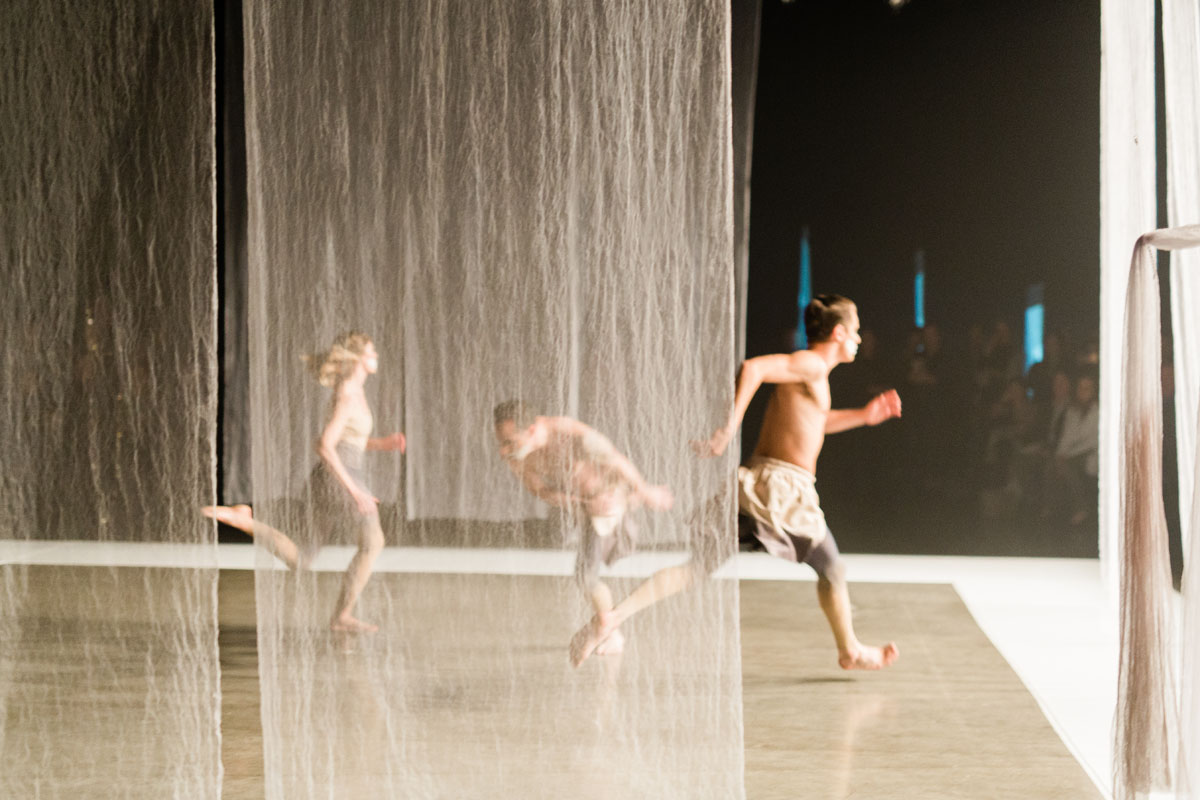
Inspired by Ghosted
Dance, Memory
When entering the space that held “Ghosted,” Tony Perrin’s “immersive artistic installation” at OZ Arts Nashville last month, my eye was drawn first to the lighted square, measuring roughly twelve by twelve. But that square, at least as I first came to it, was empty, so, looking around, I came to a row of eight diaphanous white sheets. These sheets, spaced at intervals of four feet or so, grew longer as they proceeded to the back wall.
Being projected onto and through these sheets was black and white footage of three people dancing on cracked asphalt. Shot from above, the dancers spun toward and away from one another, their movement graceful yet off-kilter—for a second I wondered if the film was running backwards or forwards. After a short while, the dancing repurposed itself to resemble a wedding procession, with the lone female dancer, her head and shoulders draped in a long white veil, held aloft by the two males.
Then the film came to life as the two male dancers emerged from the darkness. While the younger one danced in the light of the twelve-by-twelve square, the older male danced amid the sheets, under and through them. (I say older to differentiate him from the younger man in the square of light.) It was hard to discern whether he was reveling in the tactile stimulation of the sheets or flailing at them, like a startled bird amid threadbare curtains. Suddenly, he stopped to greet the bride, who came marching toward him, as if she’d stepped out of the projector itself. Together the two dancers marched through the gauze, hung a left, and joined their younger friend in the square of light. Here, amid up-tempo music, the three friends danced together, then apart, together, apart. Finally, the music slowed and it was the older man’s turn to be veiled, jewelry draped on his shoulders, and led away, exit stage left.
I have an obnoxious habit of forcing stodgy narrative frameworks on even the most abstract of performance pieces, and this is my attempt at What “Ghosted” means: The white sheets are memory, the imperfect screens for our projections, our hopes and desires. (Experts posit that the reason memory is such an unreliable steward of truth is because we don’t actually remember events as they happened so much as remember the last time we remembered them. We create copies of copies.)
The older man tangled with these threadbare sheets of his memory of happier times, when he and his beloved comingled freely. Then, after a struggle, something like the real thing came to him, and memory became reality. Then, the older man led his beloved into the light, and together the three dancers—older man and younger man (both of whom represent the same man, at different stages of his life), comingle once again, until the memory exhausts itself and the older man is escorted back into darkness, thank you for your time, please come again.
It doesn’t make total narrative sense. If the younger man and then older man represent the same man, then why are both men in the footage being projected on the white sheets? Shouldn’t it be just one of them? And how come the bride insists on dressing up the older man in veil and jewelry at the end? How’s that come into it? I suppose the What It All Means of “Ghosted” has ghosted me. And I watched it twice.
I do think “Ghosted” has something to do with memory, though, and the way one’s memories can be shaped, repurposed, redirected, treasured, discarded.
A strange thing happened to me the night I watched, witnessed, immersed myself, whatever, in “Ghosted.” It was the first truly chilly night of the fall, and so I pulled my overcoat out of the back of the closet in preparation for the night out. After the first performance, I happened to reach inside a pocket and pulled out a small, white, plastic horse.
The horse is in mid-stride, its neck strained forward, its eyes wild, tail fanned out, practically parallel to the ground. As I sat there in the dark, turning it over in my hands, I remembered picking it up during my last visit to my parents’ house, probably the previous Christmas.
That memory of course brought a flood of childhood memories, unbidden but never unwelcome, though of course nowadays many of them are tinged with the heavy, heavy knowledge that my mother is rapidly losing her memory, because of Alzheimer’s.
Yeah. It sucks. Not much more to say about it, really. These days my father my brothers and I find ourselves trading nonsense banalities when the subject is broached. “It is what it is,” gets bandied about a lot.
“Ghosted” may have helped me with that, a little, in the kind of slow-burn, leftfield way that art is capable of helping a person. It’s provided me with new vocabulary, anyway: Mom is ghosting. It feels weird to say because she’s still here, walking the Earth—I saw her at Thanksgiving, in fact. We took a walk together. Remarked on the leaves.
But it feels like she’s ghosting. Slipping away without a proper goodbye. Ghosting us, ghosting the world, ghosting herself. She’s not galloping away, not yet, but she’s not dancing either. She’s drifting, alone, in a dark and silent place outside of Memory. And meanwhile my dad and my brothers and I hang back and flail amid our shared memories, spaced evenly, all in a row. And wonder where Mom went.


